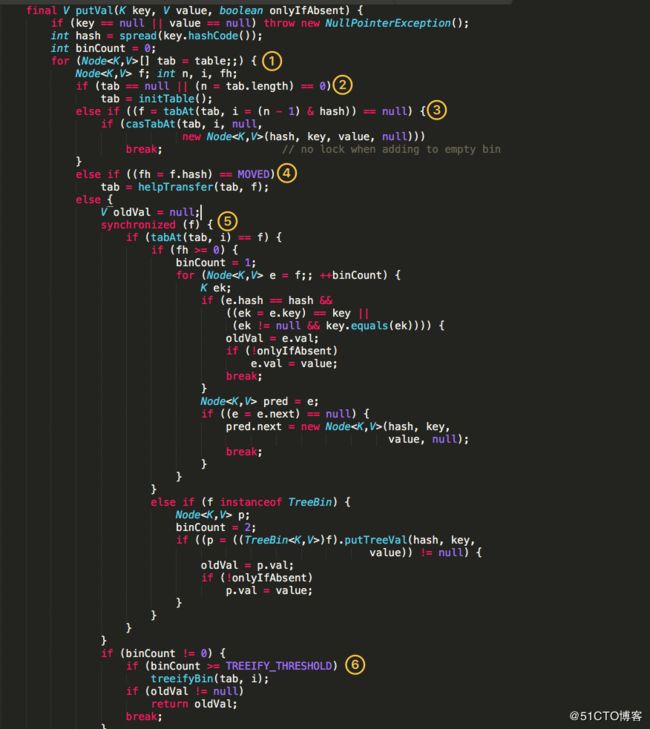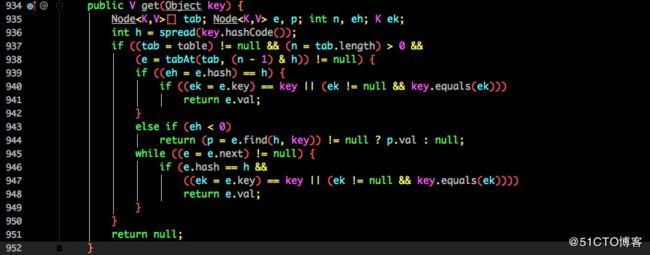前言
本文转自如下链接,由于原文的排版不是很清晰,这里进行了重新排版以及部分修改:
HashMap? ConcurrentHashMap? 相信看完这篇没人能难住你!
Map 这样的 Key Value 在软件开发中是非常经典的结构,常用于在内存中存放数据。
本篇主要想讨论 ConcurrentHashMap 这样一个并发容器,在正式开始之前我觉得有必要谈谈 HashMap,没有它就不会有后面的 ConcurrentHashMap。
JDK1.7中的HashMap
众所周知 HashMap 底层是基于 数组 + 链表 组成的,不过在 jdk1.7 和 1.8 中具体实现稍有不同。在 1.7 中HashMap的数据结构图如下:
这是 HashMap 中比较核心的几个成员变量;看看分别是什么意思?
- 初始化桶大小,因为底层是数组,所以这是数组默认的大小。
- 桶最大值。
- 默认的负载因子(0.75)
- table 真正存放数据的数组。
- Map 存放数量的大小。
- 桶大小,可在初始化时显式指定。
- 负载因子,可在初始化时显式指定。
这里重点解释一下负载因子,HashMap中共有四个构造函数,我们来看一下HashMap中较为重要的两个构造函数,源码如下:
public HashMap() {
this(DEFAULT_INITIAL_CAPACITY, DEFAULT_LOAD_FACTOR);
}
public HashMap(int initialCapacity, float loadFactor) {
if (initialCapacity < 0)
throw new IllegalArgumentException("Illegal initial capacity: " + initialCapacity);
if (initialCapacity > MAXIMUM_CAPACITY)
initialCapacity = MAXIMUM_CAPACITY;
if (loadFactor <= 0 || Float.isNaN(loadFactor))
throw new IllegalArgumentException("Illegal load factor: " + loadFactor);
this.loadFactor = loadFactor;
threshold = initialCapacity;
init();
}由于给定的 HashMap 的容量大小是固定的,而从源码中可以看到默认初始化时给定的默认容量为 16,负载因子为 0.75。Map 在使用过程中不断的往里面存放数据,当数量达到了 16 * 0.75 = 12 就需要将当前 16 的容量进行扩容,而扩容这个过程涉及到 rehash、复制数据等操作,所以非常消耗性能。
因此通常建议能提前预估 HashMap 的大小最好,尽量的减少扩容带来的性能损耗。根据代码可以看到其实真正存放数据的数组是:
transient Entry[] table = (Entry[]) EMPTY_TABLE; Entry 是 HashMap 中的一个内部类,从他的成员变量很容易看出:
- key 就是写入时的键。
- value 自然就是值。
- 开始的时候就提到 HashMap 是由数组和链表组成,所以这个 next 就是用于实现链表结构。
- hash 存放的是当前 key 的 hashcode。
知晓了基本结构后,那我们来看看其中最为重要的写入以及获取函数。
1、put 方法:
public V put(K key, V value) {
if (table == EMPTY_TABLE) {
inflateTable(threshold);
}
if (key == null)
return putForNullKey(value);
int hash = hash(key);
int i = indexFor(hash, table.length);
for (Entry e = table[i]; e != null; e = e.next) {
Object k;
if (e.hash == hash && ((k = e.key) == key || key.equals(k))) {
V oldValue = e.value;
e.value = value;
e.recordAccess(this);
return oldValue;
}
}
modCount++;
addEntry(hash, key, value, i);
return null;
} 源码说明:
- 判断当前数组是否需要初始化。
- 如果 key 为空,则 put 一个空值进去。
- 根据 key 计算出 hashcode。
- 根据计算出的 hashcode 定位出所在桶。
- 如果桶是一个链表则需要遍历判断里面的 hashcode、key 是否和传入 key 相等,如果相等则进行覆盖,并返回原来的值。
- 如果桶是空的,说明当前位置没有数据存入;新增一个 Entry 对象写入当前位置。
2、addEntry与createEntry方法:
void addEntry(int hash, K key, V value, int bucketIndex) {
if ((size >= threshold) && (null != table[bucketIndex])) {
resize(2 * table.length);
hash = (null != key) ? hash(key) : 0;
bucketIndex = indexFor(hash, table.length);
}
createEntry(hash, key, value, bucketIndex);
}
void createEntry(int hash, K key, V value, int bucketIndex) {
Entry e = table[bucketIndex];
table[bucketIndex] = new Entry<>(hash, key, value, e);
size++;
} 源码说明:
- 当调用 addEntry 写入 Entry 时需要判断是否需要扩容。
- 如果需要就进行两倍扩充,并将当前的 key 重新 hash 并定位。
- 而在 createEntry 中会将当前位置的桶传入到新建的桶中,如果当前桶有值就会在位置形成链表。
3、get 方法:
再来看看 get 方法,以及该方法内调用的 getEntry 方法:
public V get(Object key) {
if (key == null)
return getForNullKey();
Entry entry = getEntry(key);
return null == entry ? null : entry.getValue();
}
final Entry getEntry(Object key) {
if (size == 0) {
return null;
}
int hash = (key == null) ? 0 : hash(key);
for (Entry e = table[indexFor(hash, table.length)]; e != null; e = e.next) {
Object k;
if (e.hash == hash && ((k = e.key) == key || (key != null && key.equals(k))))
return e;
}
return null;
} 源码说明:
- 首先也是根据 key 计算出 hashcode,然后定位到具体的桶中。
- 判断该位置是否为链表。
- 不是链表就根据 key、key 的 hashcode 是否相等来返回值。
- 为链表则需要遍历直到 key 及 hashcode 相等时候就返回值。
- 啥都没取到就直接返回 null 。
JDK1.8中的HashMap
不知道从 1.7 的实现大家看出需要优化的点没有?其实一个很明显需要优化的地方就是:
当 Hash 冲突严重时,在桶上形成的链表会变的越来越长,这样在查询时的效率就会越来越低;时间复杂度为 O(N)。
因此在 1.8 中重点优化了这个查询效率。在 1.8 中 HashMap 的结构图:
我们先来看看在1.8中HashMap几个核心的成员变量:
/**
* The default initial capacity - MUST be a power of two.
*/
static final int DEFAULT_INITIAL_CAPACITY = 1 << 4; // aka 16
/**
* The maximum capacity, used if a higher value is implicitly specified
* by either of the constructors with arguments.
* MUST be a power of two <= 1<<30.
*/
static final int MAXIMUM_CAPACITY = 1 << 30;
/**
* The load factor used when none specified in constructor.
*/
static final float DEFAULT_LOAD_FACTOR = 0.75f;
/**
* The bin count threshold for using a tree rather than list for a
* bin. Bins are converted to trees when adding an element to a
* bin with at least this many nodes. The value must be greater
* than 2 and should be at least 8 to mesh with assumptions in
* tree removal about conversion back to plain bins upon
* shrinkage.
*/
static final int TREEIFY_THRESHOLD = 8;
/**
* The table, initialized on first use, and resized as
* necessary. When allocated, length is always a power of two.
* (We also tolerate length zero in some operations to allow
* bootstrapping mechanics that are currently not needed.)
*/
transient Node[] table;
/**
* Holds cached entrySet(). Note that AbstractMap fields are used
* for keySet() and values().
*/
transient Set> entrySet;
/**
* The number of key-value mappings contained in this map.
*/
transient int size; 可以看到,和 1.7 大体上都差不多,还是有几个重要的区别:
- TREEIFY_THRESHOLD 用于判断是否需要将链表转换为红黑树的阈值。
- HashEntry 修改为 Node。
Node 的核心组成其实也是和 1.7 中的 HashEntry 一样,存放的都是 key value hashcode next 等数据。
然后我们再来看看核心方法。
看似要比 1.7 的复杂,我们一步步进行拆解:
- 判断当前桶是否为空,空的就需要初始化(resize 中会判断是否进行初始化)。
- 根据当前 key 的 hashcode 定位到具体的桶中并判断是否为空,为空表明没有 Hash 冲突就直接在当前位置创建一个新桶即可。
- 如果当前桶有值( Hash 冲突),那么就要比较当前桶中的 key、key 的 hashcode 与写入的 key 是否相等,相等就赋值给 e,在第 8 步的时候会统一进行赋值及返回。
- 如果当前桶为红黑树,那就要按照红黑树的方式写入数据。
- 如果是个链表,就需要将当前的 key、value 封装成一个新节点写入到当前桶的后面(形成链表)。
- 接着判断当前链表的大小是否大于预设的阈值,大于时就要转换为红黑树。
- 如果在遍历过程中找到 key 相同时直接退出遍历。
- 如果 e != null 就相当于存在相同的 key,那就需要将值覆盖。
- 最后判断是否需要进行扩容。
2、get 方法(get 里调用的是getNode):
public V get(Object key) {
Node e;
return (e = getNode(hash(key), key)) == null ? null : e.value;
}
final Node getNode(int hash, Object key) {
Node[] tab; Node first, e; int n; K k;
if ((tab = table) != null && (n = tab.length) > 0 &&
(first = tab[(n - 1) & hash]) != null) {
if (first.hash == hash && // always check first node
((k = first.key) == key || (key != null && key.equals(k))))
return first;
if ((e = first.next) != null) {
if (first instanceof TreeNode)
return ((TreeNode)first).getTreeNode(hash, key);
do {
if (e.hash == hash &&
((k = e.key) == key || (key != null && key.equals(k))))
return e;
} while ((e = e.next) != null);
}
}
return null;
} get 方法看起来就要简单许多了:
- 首先将 key hash 之后取得所定位的桶。
- 如果桶为空则直接返回 null 。
- 否则判断桶的第一个位置(有可能是链表、红黑树)的 key 是否为查询的 key,是就直接返回 value。
- 如果第一个不匹配,则判断它的下一个是红黑树还是链表。
- 红黑树就按照树的查找方式返回值。
- 不然就按照链表的方式遍历匹配返回值。
从这两个核心方法(get/put)可以看出 1.8 中对大链表做了优化,修改为红黑树之后查询效率直接提高到了 O(logn)。
但是 HashMap 原有的问题也都存在,比如在并发场景下使用时容易出现死循环,如下示例:
final HashMap map = new HashMap();
for (int i = 0; i < 1000; i++) {
new Thread(new Runnable() {
@Override
public void run() {
map.put(UUID.randomUUID().toString(), "");
}
}).start();
} 但是为什么呢?我们来简单分析一下。上文中提到在 HashMap 扩容的时候会调用 resize() 方法,就是这里的并发操作容易在一个桶上形成环形链表;这样当获取一个不存在的 key 时,计算出的 index 正好是环形链表的下标就会出现死循环。
HashMap的遍历方式
还有一个值得注意的是 HashMap 的遍历方式,通常有以下几种:
public static void main(String[] args) {
Map map = new HashMap<>();
map.put("a", 1);
map.put("b", 2);
Iterator> entryIterator = map.entrySet().iterator();
while (entryIterator.hasNext()) {
Map.Entry next = entryIterator.next();
System.out.println("key=" + next.getKey() + " value=" + next.getValue());
}
Iterator iterator = map.keySet().iterator();
while (iterator.hasNext()) {
String key = iterator.next();
System.out.println("key=" + key + " value=" + map.get(key));
}
// 等同于第一种方式
for (Map.Entry entry : map.entrySet()) {
System.out.println("key=" + entry.getKey() + " value=" + entry.getValue());
}
} 强烈建议使用 EntrySet 进行遍历。第一种和第三种遍历方式都可以把 key value 同时取出,而第二种还得需要通过 key 取一次 value,效率较低。
简单总结下 HashMap:
无论是 1.7 还是 1.8 其实都能看出 JDK 没有对它做任何的同步操作,所以并发会出问题,甚至出现死循环导致系统不可用。
因此 JDK 推出了专项专用的 ConcurrentHashMap ,该类位于 java.util.concurrent 包下,专门用于解决并发问题。坚持看到这里的朋友算是已经把 ConcurrentHashMap 的基础已经打牢了,下面正式开始分析。
JDK1.7中的ConcurrentHashMap
ConcurrentHashMap 同样也分为 1.7 、1.8 版,所以两者在实现上略有不同。同样的,我们先来看看 1.7 的实现,下面是它的结构图:
如图所示,是由 Segment 数组、HashEntry 组成,和 HashMap 一样,仍然是数组加链表。
它的核心成员变量:
/**
* Segment 数组,存放数据时首先需要定位到具体的 Segment 中。
*/
final Segment[] segments;
transient Set keySet;
transient Set> entrySet; 其中Segment 是 ConcurrentHashMap 的一个内部类,主要的组成如下:
static final class Segment extends ReentrantLock implements Serializable {
private static final long serialVersionUID = 2249069246763182397L;
// 和 HashMap 中的 HashEntry 作用一样,真正存放数据的桶
transient volatile HashEntry[] table;
transient int count;
transient int modCount;
transient int threshold;
final float loadFactor;
} 和 HashMap 非常类似,唯一的区别就是其中的核心数据如 value ,以及链表都是 volatile 修饰的,保证了获取时的可见性。
原理上来说:
ConcurrentHashMap 采用了分段锁技术,其中 Segment 继承于 ReentrantLock。不会像 HashTable 那样不管是 put 还是 get 操作都需要做同步处理,理论上 ConcurrentHashMap 支持 CurrencyLevel (Segment 数组数量)的线程并发。每当一个线程占用锁访问一个 Segment 时,不会影响到其他的 Segment。
下面也来看看核心的 put get 方法。
put 方法:
public V put(K key, V value) {
Segment s;
if (value == null)
throw new NullPointerException();
int hash = hash(key);
int j = (hash >>> segmentShift) & segmentMask;
if ((s = (Segment)UNSAFE.getObject // nonvolatile; recheck
(segments, (j << SSHIFT) + SBASE)) == null) // in ensureSegment
s = ensureSegment(j);
return s.put(key, hash, value, false);
} 首先是通过 key 定位到 Segment,之后在对应的 Segment 中进行具体的 put:
final V put(K key, int hash, V value, boolean onlyIfAbsent) {
HashEntry node = tryLock() ? null :
scanAndLockForPut(key, hash, value);
V oldValue;
try {
HashEntry[] tab = table;
int index = (tab.length - 1) & hash;
HashEntry first = entryAt(tab, index);
for (HashEntry e = first;;) {
if (e != null) {
K k;
if ((k = e.key) == key ||
(e.hash == hash && key.equals(k))) {
oldValue = e.value;
if (!onlyIfAbsent) {
e.value = value;
++modCount;
}
break;
}
e = e.next;
}
else {
if (node != null)
node.setNext(first);
else
node = new HashEntry(hash, key, value, first);
int c = count + 1;
if (c > threshold && tab.length < MAXIMUM_CAPACITY)
rehash(node);
else
setEntryAt(tab, index, node);
++modCount;
count = c;
oldValue = null;
break;
}
}
} finally {
unlock();
}
return oldValue;
} 虽然 HashEntry 中的 value 是用 volatile 关键词修饰的,但是并不能保证并发的原子性,所以 put 操作时仍然需要加锁处理。
首先第一步的时候会尝试获取锁,如果获取失败肯定就有其他线程存在竞争,则利用 scanAndLockForPut() 自旋获取锁。
源码说明:
- 尝试自旋获取锁。
- 如果重试的次数达到了 MAX_SCAN_RETRIES 则改为阻塞锁获取,保证能获取成功。
再结合图看看 put 的流程:
- 将当前 Segment 中的 table 通过 key 的 hashcode 定位到 HashEntry。
- 遍历该 HashEntry,如果不为空则判断传入的 key 和当前遍历的 key 是否相等,相等则覆盖旧的 value。
- 不为空则需要新建一个 HashEntry 并加入到 Segment 中,同时会先判断是否需要扩容。
- 最后会解除在 1 中所获取当前 Segment 的锁。
get 方法:
public V get(Object key) {
Segment s; // manually integrate access methods to reduce overhead
HashEntry[] tab;
int h = hash(key);
long u = (((h >>> segmentShift) & segmentMask) << SSHIFT) + SBASE;
if ((s = (Segment)UNSAFE.getObjectVolatile(segments, u)) != null &&
(tab = s.table) != null) {
for (HashEntry e = (HashEntry) UNSAFE.getObjectVolatile
(tab, ((long)(((tab.length - 1) & h)) << TSHIFT) + TBASE);
e != null; e = e.next) {
K k;
if ((k = e.key) == key || (e.hash == h && key.equals(k)))
return e.value;
}
}
return null;
} get 逻辑比较简单:
- 只需要将 Key 通过 Hash 之后定位到具体的 Segment ,再通过一次 Hash 定位到具体的元素上。
- 由于 HashEntry 中的 value 属性是用 volatile 关键词修饰的,保证了内存可见性,所以每次获取时都是最新值。
- ConcurrentHashMap 的 get 方法是非常高效的,因为整个过程都不需要加锁。
JDK1.8中的ConcurrentHashMap
1.7 已经解决了并发问题,并且能支持 N 个 Segment 这么多次数的并发,但依然存在 HashMap 在 1.7 版本中的问题。那就是查询遍历链表效率太低。因此 1.8 做了一些数据结构上的调整。
看起来是不是和 1.8 HashMap 结构类似?其中抛弃了原有的 Segment 分段锁,而采用了 CAS + synchronized 来保证并发安全性:
也将 1.7 中存放数据的 HashEntry 改为 Node,但作用都是相同的。其中的 val next 都用了 volatile 修饰,保证了可见性。
源码说明:
- 根据 key 计算出 hashcode 。
- 判断是否需要进行初始化。
- f 即为当前 key 定位出的 Node,如果为空表示当前位置可以写入数据,利用 CAS 尝试写入,失败则自旋保证成功。
- 如果当前位置的 hashcode == MOVED == -1,则需要进行扩容。
- 如果都不满足,则利用 synchronized 锁写入数据。
- 如果数量大于 TREEIFY_THRESHOLD 则要转换为红黑树。
源码说明:
- 根据计算出来的 hashcode 寻址,如果就在桶上那么直接返回值。
- 如果是红黑树那就按照树的方式获取值。
- 就不满足那就按照链表的方式遍历获取值。
1.8 在 1.7 的数据结构上做了大的改动,采用红黑树之后可以保证查询效率(O(logn)),甚至取消了 ReentrantLock 改为了 synchronized,这样可以看出在新版的 JDK 中对 synchronized 优化是很到位的。
总结
看完了整个 HashMap 和 ConcurrentHashMap 在JDK 1.7 和 1.8 中不同的实现方式相信大家对他们的理解应该会更加到位。其实这块也是面试的重点内容,通常的套路是:
- 谈谈你理解的 HashMap,讲讲其中的 get/put 过程。
- 1.8 中对HashMap做了什么优化?
- HashMap是线程安全的嘛?
- 不安全会导致哪些问题?
- 如何解决?有没有线程安全的并发容器?
- ConcurrentHashMap 是如何实现的? 1.7、1.8 实现有何不同?为什么这么做?
这一串问题相信大家仔细看完都能怼回面试官。除了面试会问到之外平时的应用其实也蛮多,像之前谈到的 Guava 中 Cache 的实现就是利用 ConcurrentHashMap 的思想。同时也能学习 JDK 作者大牛们的优化思路以及并发解决方案。









